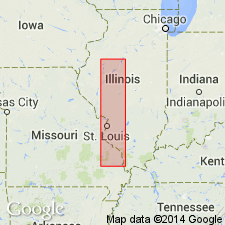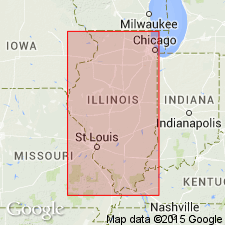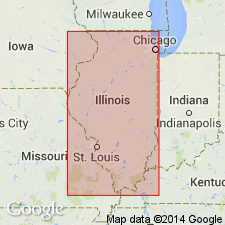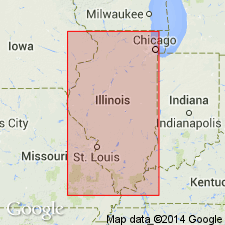
- Usage in publication:
-
- Morton loess
- Modifications:
-
- Original reference
- Dominant lithology:
-
- Loes
- AAPG geologic province:
-
- Illinois basin
Summary:
Pg. 2 (fig. 1), 7, 11. Morton loess. Name applied to pro-Shelbyville loess, formerly called Iowan loess. Calcareous fossiliferous yellow-tan to gray massive silt. At type section, occurs in stratigraphic succession above Farmdale silt and below Shelbyville till. Name for Iowan loess as a rock-stratigraphic unit necessary because radiocarbon dates have demonstrated that Morton loess is at least 15,000 radiocarbon years younger than type Iowan of Iowa. Age is Pleistocene (Wisconsinan; Woodfordian subage).
Type section [no longer exposed, ca. 1996 (see Hansel and Johnson, 1996)]: Farm Creek RR cut section, 6 mi (9.6 km) northwest of Morton, in center sec. 31, T. 26 N., R. 3 W., Tazewell Co., central northern IL. Named from village of Morton, Tazewell Co., central northern IL.
Source: US geologic names lexicon (USGS Bull. 1200, p. 2609-2610).

- Usage in publication:
-
- "Morton loess"
- Modifications:
-
- Not used
- AAPG geologic province:
-
- Illinois basin
Summary:
Pg. 541. "Morton loess." Presentation of classification of Wisconsin glacial stage of north-central United States. Paper also gives consideration to other classifications including one proposed by Frye and Willman. They proposed renaming Iowan loess, "Morton loess." Town of Morton is in central Illinois 100 miles away from where loess has its phenomenal expression at Iowan drift margin. Morton loess is referred to by Frye and Willman as "pro-Shelbyville loess" without presentation of evidence. "Pro-Shelbyville" should imply that the valley train from which loess was blown came from advancing Shelbyville glaciers. This is not true. Wood from top of Iowan loess in Farm Creek sections averages 1,700 years older than wood from very base of Shelbyville till. Because Labradorean-Iowan came from same direction as Shelbyville glacier, it is possible that Iowan loess may be in part blown from a pro-Labradorean-Iowan valley train.
Source: US geologic names lexicon (USGS Bull. 1200, p. 2609-2610).

- Usage in publication:
-
- Morton Loess
- Modifications:
-
- Overview
- AAPG geologic province:
-
- Illinois basin
Summary:
Pg. 228. Morton Loess. Formerly called Peorian loess (Alden and Leighton, 1917, Iowa Geol. Survey Ann. Rpt., 1915, v. 26, p. 49-212) and later Iowan loess (Leighton, 1933, Sci., v. 77, p. 168; Leighton and Willman, 1950, Jour. Geol., v. 58, p. 599-623). Consists of gray to gray-tan, massive, calcareous silt. Thickness up to 10 feet. Occurs above Robein Silt or Farmdale Soil developed in Roxana Silt and lies below Wedron Formation. Occurs only within area of Woodfordian glaciation, but is physically continuous with lower part of Peoria Loess, which lies outside of area. Fossiliferous. Radiocarbon dates indicate a time span from 22,000 to 20,000 yr B.P. Age is Pleistocene (Wisconsinan Age; Woodfordian Subage).
Source: Publication.

- Usage in publication:
-
- Morton Tongue*
- Modifications:
-
- Principal reference
- Revised
- AAPG geologic province:
-
- Illinois basin
Summary:
Pg. 15, 17 (fig. 9), 18, 21, 32 (fig. 16), 54, 55-56, 75, 82+, 107-108. Morton Tongue of Peoria Silt of Mason Group. A subsurface, wedge-shaped unit that is generally unbedded, gray to yellow tan, dolomitic, fossiliferous silt. Thickness less than 6.6 feet (2 m). Overlies Robein Member of Roxana Silt or older units. Underlies Ashmore Tongue of Henry Formation, Peddicord Tongue of Equality Formation, or Delavan Member of Tiskilwa Formation. Equivalent to part of Atherton Formation of Indiana. Interpreted to be a proglacial loess. Age is Pleistocene (Wisconsinan Age; Woodfordian Subage), based on radiocarbon dating.
Principal reference sections:
(1) Danvers (Rock Creek) section, in cutbank on south side of Rock Creek, in NW/4 NE/4 NW/4 sec. 32, T. 25 N., R. 1 W., Danvers 7.5-min quadrangle, Woodford Co., IL;
(2) Farm Creek section, on south side of Farm Creek, in NE/4 SW/4 SE/4 sec. 30, T. 26 N., R. 3 W., Washington 7.5-min quadrangle, Tazewell Co., IL;
(3) Gardena section, exposed in stream bank 99 ft (30 m) west (downstream) of Toledo, Peoria, and Western RR bridge, in NW/4 SW/4 NW/4 sec. 32, T. 26 N., R. 3 W., Washington 7.5-min quadrangle, Tazewell Co., IL;
(4) Glendale School section, in north valley wall of a minor tributary of Farm Creek, in SE/4 SW/4 NE/4 sec. 3, T. 25 N., R. 4 W., Peoria East 7.5-min quadrangle, Tazewell Co., IL.
Source: Publication.
For more information, please contact Nancy Stamm, Geologic Names Committee Secretary.
Asterisk (*) indicates published by U.S. Geological Survey authors.
"No current usage" (†) implies that a name has been abandoned or has fallen into disuse. Former usage and, if known, replacement name given in parentheses ( ).
Slash (/) indicates name conflicts with nomenclatural guidelines (CSN, 1933; ACSN, 1961, 1970; NACSN, 1983, 2005, 2021). May be explained within brackets ([ ]).

